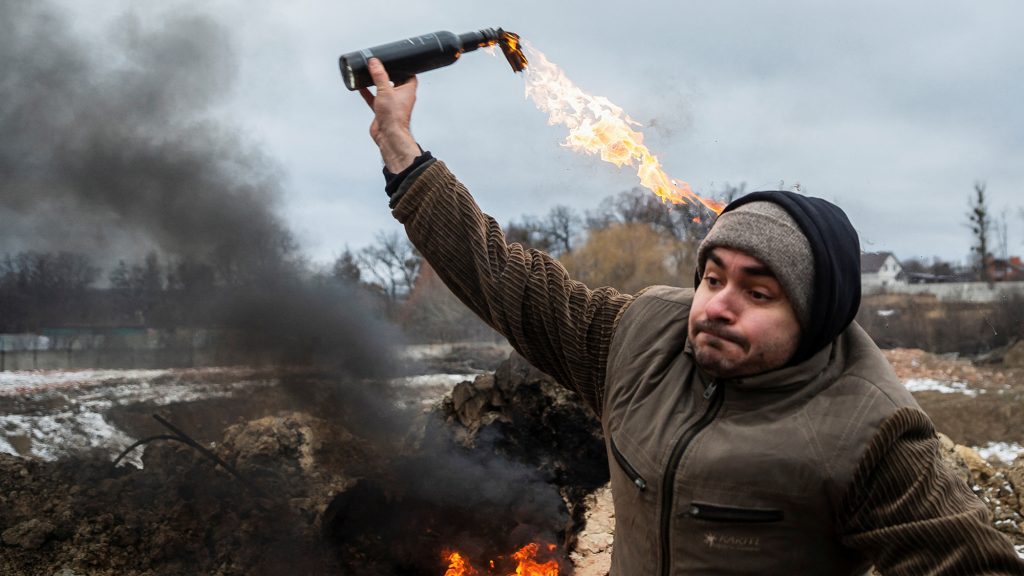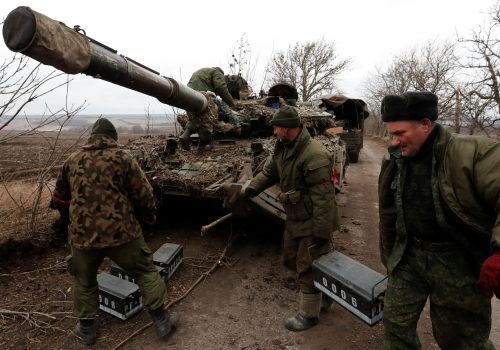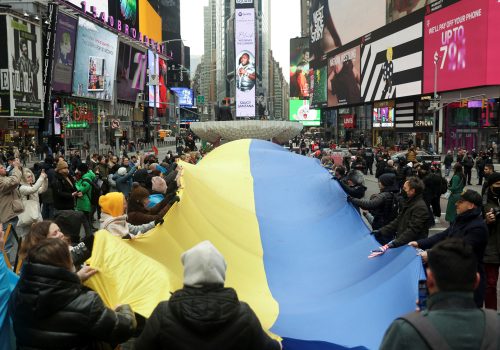As Russian forces approached the northern outskirts of Kyiv last week, Ukraine’s defense ministry sent out a tweet urging the capital city’s citizens to “prepare Molotov cocktails.”
The incendiary weapon, popular with revolutionaries, insurgents, protesters, and routine troublemakers for nearly a century, earned its name during the 1939 Soviet invasion of Finland, known as the Winter War.
Moscow’s troops entered Finland on November 30, 1939, confident that they could conquer the country in three weeks. After all, Finland had only gained an army following its independence from the Soviet Union in 1918. The Finns, however, would not roll over without a fight. Legend goes that when one Finnish soldier saw the Soviet army advancing on his homeland, he remarked, “So many Soviets. Where will we find room to bury them all?”
To the world’s amazement, the vastly outnumbered and outgunned Finns ground the Soviets to a draw by mobilizing the entire Finnish nation. Their regular forces met the Soviets’ relentless assault at the Mannerheim Line, a series of fortifications Finland put in place on the Karelian Isthmus to defend against an attack from Moscow. They also defeated the Soviets in crucial pitched battles in the north by using the terrain to their advantage. One final and vital ingredient of the feisty Finns? Sisu—a Finnish word that translates roughly to “guts” or “chutzpah.”
It took some serious sisu for an individual soldier to face down a column of tanks. The tanks, however, literally had a chink in their armor: an air vent on the back. By causing a fire there, you could smoke out the soldiers inside.
That’s what Francisco Franco’s Spanish nationalists did, three years earlier, against Soviet T-26 tanks. In the Winter War, the Finns made the tactic their own. A Finnish soldier would run up to the tank, smash the bottle against the vent, and run for cover. When the Soviets emerged, they would be greeted with bullets from Suomi submachine guns.
With the dry, macabre humor typical of the Finns (and, as we have seen, of any nation unfortunate enough to border Russia), they dubbed the bottled weapon a Molotov Cocktail after the Soviet foreign minister who had claimed that his country’s bombers were merely dropping food supplies over Helsinki. This was the proper drink to go with the alleged food.
What can we learn from the Winter War?
First, the Russian playbook hasn’t changed much. In September 1939, the Soviets invited the Finns to Moscow to negotiate the “peaceful” stationing of Soviet troops on their soil. The Finns refused. Moscow kept up negotiations for another two months while massing their forces on Finland’s border. When their build-up was complete, the Soviets fired artillery on their own forces, blamed it on Finland, and used it as a pretext for invasion.
Second, the Molotov Cocktail and the David vs. Goliath ethos epitomized by the Finns in 1939 remain as relevant today as they did eight decades ago. The incendiary itself has been widely used in protests across the world in recent years. It can be made at home with simple ingredients and packs fifteen times the energy of gunpowder. However, the lesson from the Finnish example is even more powerful than the cocktail itself: A smaller force of dedicated soldiers and citizens can fight off a massive invasion by Moscow.
The Finns made full use of their well-developed home guard, who grew up on skis. They rigged explosives under frozen lakes, taking out entire columns of Soviet tanks. The Finns capitalized on their forests’ canalizing effects (meaning the terrain forced the Soviets to move down narrow lines, making them easier targets) by cutting pathways through the woods parallel to Soviet lines, skiing alongside, firing, then skiing off to harass a different section.
Finally, it’s important to remember that despite their heroism, the Finns were eventually forced to negotiate with Moscow for peace and cede large amounts of land in Karelia. They had successfully repulsed the initial invasion and caused horrific Soviet casualty levels. However, when the Soviets refocused all their forces in a push to capture Helsinki, the Finns ran out of everything—ammunition, artillery, and weapons.
Though the world watched in admiration, no one sent military aid to Finland. It was 1939, and war was on elsewhere in Europe. So, the Finns fought on their own, with Molotov Cocktails and weaponry they captured from the Soviets.
The Ukrainian plains are far more open than the Finnish forests, but the city streets are a treacherous place to fight. Soviet forces never made it to Helsinki, but Russian troops are advancing on Kyiv. A cyber war is raging, and air and anti-air capabilities are playing a critical role. Crucially, the Ukrainians have made excellent use of the Javelins, Stingers, and other weapons systems provided by the United States and Europe, who are wide awake to Moscow’s machinations this time around. The typically neutral Finns have even chipped in weaponry—beyond their old cocktail recipe.
On Monday, the Ukrainian general staff tweeted a diagram of various Russian military vehicles, pointing out their weaknesses and where to aim Molotov Cocktails for maximum effect. It may take a few days before Ukrainian soldiers and civilians hone their homemade incendiary tactics. Early videos published online show mixed results. For example, throwing a burning bottle from your own car might harm your target, but it could also harm you. Throwing one down from a window onto a vehicle canalized in the street could prove quite effective.
Citizens may be prepping Molotov Cocktails again, but this winter war is already different. If military aid continues to flow to Ukraine, Kyiv will never be alone the way Helsinki was.
Capt. Ann Marie Dailey is an engineer officer in the US Army. Prior to commissioning, she served as a senior advisor on Russia strategy in the Office of the Secretary of Defense for Policy, US Department of Defense. The views expressed are those of the author and do not reflect the official position of the Department of the Army or Department of Defense.
Further reading
Tue, Mar 1, 2022
Four ways the war in Ukraine might end
New Atlanticist By Barry Pavel, Peter Engelke, Jeffrey Cimmino
The United States, its transatlantic allies and partners, and the entire world face a difficult period of sustained contestation with Russia.
Mon, Feb 28, 2022
Russian forces capture key Ukraine nuclear plant
New Atlanticist By
Follow along for the latest insights, analysis, and reporting from the Atlantic Council's experts as Russia steps up its military assault on Ukraine.
Thu, Feb 24, 2022
Experts React: Russia has launched a war against Ukraine. How can the West fight back?
New Atlanticist By
Our experts are weighing in with their thoughts about where this conflict is going and how the West can fight back.
Image: A civilian trains to throw Molotov cocktails to defend the city, as Russia's invasion of Ukraine continues, in Zhytomyr, Ukraine on March 1, 2022. Photo via REUTERS/Viacheslav Ratynskyi.



